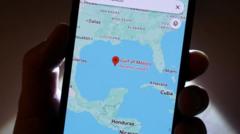In a notable clash over cartography, Mexican President Claudia Sheinbaum has formally asked technology giant Google to retain the traditional name of the Gulf of Mexico, despite a controversial order from the United States government. The request comes in response to a directive signed by former President Donald Trump, demanding that the Gulf of Mexico be referred to as the "Gulf of America" within US territory.
Sheinbaum’s letter highlights that the proposed name change, which will only appear on Google Maps for users in the United States, undermines the longstanding geographical and cultural significance of the name Gulf of Mexico, a designation recognized globally for many centuries. The Gulf is bordered by the US, Cuba, and Mexico, and according to international maritime law, the rights to name bodies of water fall under the jurisdiction of no single nation.
Furthermore, Sheinbaum points to the United Nations Convention on the Law of the Sea, which stipulates that a country's territorial claims extend a mere 12 nautical miles from its coastline. “[The name change] could only correspond to the 12 nautical miles away from the coastlines of the United States of America,” she noted in her correspondence with Google.
While Google has yet to publicly respond to the request, a representative stated that the company typically updates names based on official government sources. This practice has led to other contentious changes, such as the planned renaming of Mount Denali back to Mount McKinley within the US.
The Mexican President has been vocal against the influence of the US in nomenclature decisions regarding international waters. In a lighthearted jab at the situation, she quipped about potentially asking Google to adopt "Mexican America" as a name for the continent.
Despite these changes primarily occurring in US-focused platforms, Sheinbaum reiterates that, for Mexico and the world, the body of water will always be recognized as the Gulf of Mexico.





















